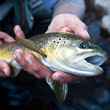We’ve all been there. You spy a trout finning in the current, not too far off the bank, oblivious to your presence. A perfect target. Easy, even. You stand quiet and still, assess the current, watch the fish’s behavior to see if you can discern what it is or isn’t eating, and envision your cast. Only to make it, you’ll need to get a bit closer. The good news is, that shouldn’t be a problem. The fish is 40 or 50 feet upstream and barely a rod length off the shoreline. You’ll practically be walking up straight behind it, able to sneak up close and personal for a short cast. You strip line off your reel, unbutton your fly from the rod guide it’s hitched to, and take your first step. The fish bolts for cover and is gone.
To explain this seemingly inexplicable behavior, anglers will commonly leverage the old adage which suggests that “fish has eyes in the back of its head,” even if during its use in a bankside lamentation “fish” might get replaced by one expletive or another. Of course, fish don’t have eyes in the back of their heads. They have eyes on the sides of their heads. So how did your quarry, lacking eyes on the back of its head, manage to see you approaching from, for all intents and purposes, directly behind it?
To fully answer that question, a complex understanding of what is commonly referred to as “the fish’s window” is needed. Doing so requires that one spend a fair bit of time studying concepts such as optical density, the refractive index of different mediums, and understanding (or at least attempting to) how light rays bend when they pass between one medium and another. In the case of the fish’s window, those mediums are air and water and how light rays are redirected (refracted) when they pass between those two mediums is based on a number of different factors including, but not limited to, the angle of incidence at which light passing through air meets the surface of the water. It’s heady stuff, without doubt.
Thankfully, comprehending the bulk of how and why the fish you had planned to toss that gimme cast to was able to flee for the safety of a cutbank or weedbed before you got the opportunity requires far less — little more than a cursory examination of the fish’s anatomy. To aid in that examination, it is helpful to compare the fish’s anatomy to our own. Doing so will serve as a helpful reminder of how we differ from our quarry, one we can leverage on the streambank to help make our pursuit more stealthy and well-planned.
There are many notable differences between our optical anatomy and that of the fish we chase — lens shape, focusing mechanisms, and so on. For the purposes of this discussion, however, one difference is paramount: eye placement. As mentioned, fish have eyes on the sides of their heads. We humans have our eyes firmly planted on the front of our heads. Though it remains a subject of debate precisely why these anatomical differences evolved, it is widely accepted that predator species (humans, other non-human primates, cats, and owls, for instance) derive an evolutionary advantage from front-facing eye placement, while prey species (fish, rodents, ungulates and many more) derive an advantage from side-facing eye placement.

For humans and other predators, the advantage from our front-facing eyes comes as a result of the overlap between the field of vision provided by each of our eyes. Where these fields overlap, the brains of humans and other animals with eyes on the front of their heads are able to process these signals and interpret them as binocular or stereoscopic vision, offering greatly enhanced depth perception. For humans, that stereoscopic field of view is around 120 degrees. The tradeoff comes in our overall field of vision. Humans and other predators have huge blind spots. While we may have a wide field of binocular vision, our overall field of vision is only about 60 to 80 degrees wider (approximately 180-200 degrees in total). That means that we humans can’t see almost everything behind us. Given that is the way in which we’ve all viewed the world around us since birth, it’s also why we reflexively assume we can sneak up behind our prey without being seen. But it pays to remind ourselves that’s not the case.
Prey species, by comparison, have a very small field of binocular vision and comparatively poor depth perception. Due to the placement of their eyes on the sides of their heads, there is little overlap between the field of vision of each eye. Most fish have a mere 30 degrees or so of stereoscopic vision. Much like with our forward facing eyes, however, there’s a tradeoff. And, for the fish, it’s an important one. Compared to our paltry 180-200 degree overall field of view, the fish’s worldview is immense — around 330 degrees (for species with notably flat bodies, such as panfish, that window can be even greater, as much as 340 or 350 degrees).
Even a glance at the above illustration, intended to provide a generalized view of the field of vision of a fish when compared to that of a human, will quickly answer the question of how and why fish so commonly seem to have “eyes in the back of their heads.”
If that weren’t enough, there’s more. Most fish species have muscles that allow them to rotate their entire eye — upward, downward, forward and backward — to redirect their field of vision. No doubt most anglers have witnessed this phenomenon directly when observing a fish in the net or in the hand. Given this additional adaptation, it is reasonable to assume that a fish’s true field of vision is very near a full 360 degrees.
Can fish see directly behind them? Bet on it. Your angling will improve as a result.































Comments
William Nelson replied on Permalink
Great article! Another candidate for why the trout spooked is that it ‘heard’ your approach. Your boots walking in the stream over rocks, debris, etc produce sounds that can be felt by a trout. The need to minimize sound is paramount.
Pages